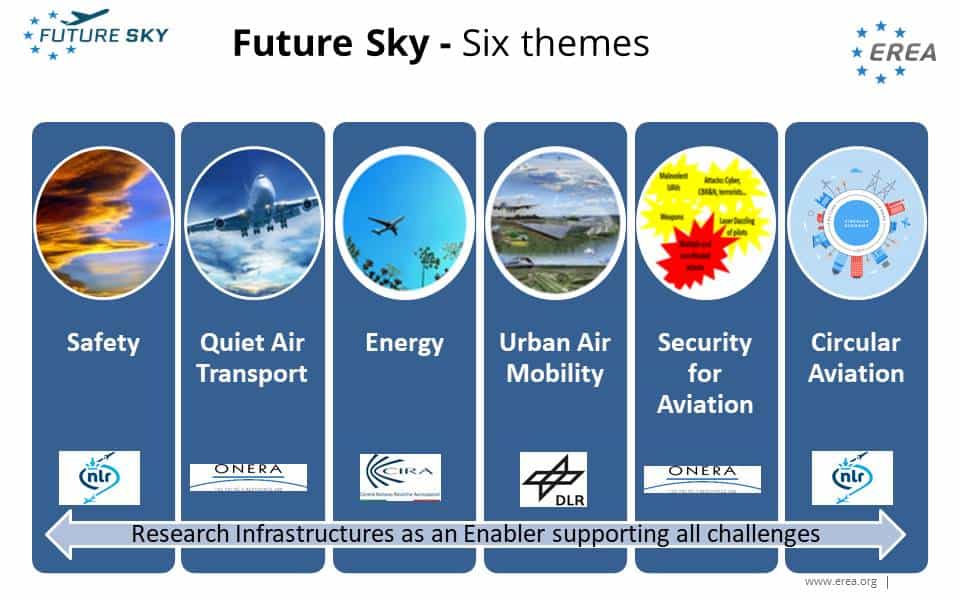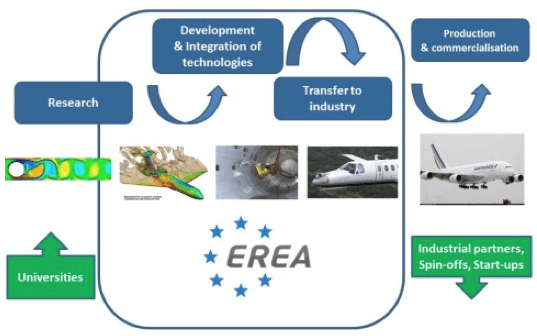EREA, the association of European Research Establishments in Aeronautics launches Future Sky: a Joint Research Initiative in which development and integration of aviation technologies is taken to the European level.
Future Sky (FS) is a Joint Research Initiative of the Association of European Research Establishments in Aeronautics (EREA) devoted to preparing key technologies and capabilities for a green and seamless air transport in Europe. Within Future Sky EREA promotes joining forces with the European industry and universities to design a new air transport system allowing environmentally friendly, smooth and efficient air vehicles and associated mobility.
Green and seamless air transport is to be thought as a key element for the most far-reaching goals of Flightpath 2050. Striving for a substantial increase in performance, safety, competitiveness, and acceptance, Future Sky aims at promoting maximum air mobility while making the highest demands on technologies as well as vehicle, system and operation design.

Future Sky seeks to rally the available but so far scattered capabilities to tackle the major longer-term challenges of Flightpath 2050. For this reason main feature of this program will be the coordination, as far as possible, of research establishments’ efforts in the field of aviation research in Europe. EREA believes institutional cooperation of European research establishments is the best guarantee to ensure medium and long term technology development beyond the scope of top-down approach in SESAR 2020 and Clean Sky 2 JUs.
In Future Sky national research establishments develop and pursue roadmaps covering at least a period of seven years addressing the complete air transport system and tackling research gaps not fully covered by the national institutional research programs. To fill these gaps subsequent Future Sky themes are intended to grow into multidisciplinary clusters of excellence for research and innovation in Europe. Thereby Future Sky makes a substantial contribution to achieving the medium and long term goals of Flightpath 2050 and helps preparing the Framework Programs to come.
Collaboration of national research establishments
The national research establishments that have gathered in EREA are all committed to contribute to Future Sky. For each joint research programme, the national research establishments propose roadmap for the next five to seven years. The research establishments map out which areas of a certain research theme are covered by their institutional research programmes and where they see opportunities for sharing results and joint planning. The roadmap also identify certain research gaps that are not yet or insufficiently covered by the national institutional research programmes. These gaps will be tackled in a new European research project in which the research establishments will actively seek to collaborate with universities and industry. The aim of Future Sky is to enhance collaboration between national establishments and to involve the aviation research community as whole to prepare for a competitive European aviation industry in 2050.
How Future Sky contributes to Flightpath 2050
In order to fulfil Flightpath 2050 goals European aviation research needs to target the complete Air Transport System and to apply a full life cycle engineering approach, covering the full research and innovation chain. The ACARE SRIA envisages putting in place attractive and efficient research instruments, which ensure continuity between research on promising breakthrough concepts, their validation by focussed RTD actions and finally their demonstration in an integrated environment.
Furthermore Flightpath 2050 and the ACARE SRIA are proposing to establish multidisciplinary clusters of excellence for research and innovation, to achieve common technology goals (outcome of a common strategy to address societal issues). They ensure that the appropriate organisations are tackling activities at the appropriate level in the innovation chain. For demonstration activities on system level the well-known JTI concept lead by industry has been proven to be successful.
Future Sky combines the power and the capacities of the research establishments in EREA into multidisciplinary clusters of excellence proposed by Flightpath 2050 in order to ensure appropriate mid and long term research on lower level TRLs complementing the industrial lead demonstration activities on higher TRLs. As mentioned above Future Sky is devoted to preparing key technologies and capabilities for a green and seamless air transport in Europe. Within Future Sky EREA promotes joining forces with the European industry and universities to design a new air transport system allowing environmentally friendly, smooth and efficient air vehicles and associated mobility.
Outreach and Expected Impact of Future Sky
FLIGHTPATH 2050 GOALS
Future Sky substantially contributes to Europe’s vision of a future air transport system coming true. Reaching two generations of ATS ahead, Future Sky paves the way for joint European demonstrator programs succeeding Clean Sky and SESAR. Furthermore, Future Sky provides a platform for an international outreach in pre-competitive fields of aviation and ATS research.
COORDINATION
Future Sky by its very nature strongly fosters cooperation and linking of the European research establishments. In doing so, Future Sky maps capacities and capabilities of the research establishment and publicises competencies and interests among universities, research establishment and industry strengthening the Europe-wide network in aviation research and development.
KNOWLEDGE
To prepare technologies for the future, knowledge and expertise are needed, including the relation of local (national) knowledge to European strategic knowledge. While the top-down approach in Clean Sky and SESAR supports the knowledge building process for products mainly at the OEM and SME side, Future Sky contributes to enhancing knowledge transfer, including the transfer to the next generations. Building a bridge between universities and industry on a European level, Future Sky contributes largely to the education of future aviation engineers and scientists, the core resource of Europe’s future.
COMPETITIVENESS
The top-down approach in Clean Sky as well as SESAR adds to the competitiveness of the next generation of products and European ATM. Future Sky adds to the scientific and technology basis for future aviation business beyond this scope, for the next but one generation of products and ATS.
ATTRACTION
Some 100 years ago, aeronautics fascinated the public because it was an adventure. Some 50 years ago, aviation fascinated because all-new products such as the B747 or the Concorde were perceived as the incarnation progress. At present, aviation seems to have become a business just like any other. However, there are still physical limits to be explored in the future; there are new challenges and possibilities, asking for new approaches in thinking and therefore for creative people. Future Sky addresses this field, and makes aviation fascinating again for the public. Even though this is an indirect goal, it is of high importance, not only within aviation.
The Joint Research Programmes under Future Sky
The Future Sky Initiative consists in multidisciplinary programs – so-called Future Sky Themes – where major innovation areas of future ATS will be investigated (EREA internal organisation in Fig. 1). As described previously, the main features of the ATS that Future Sky wishes to promote are its resilience and environment-friendliness (green & seamless). Each cluster will investigate aspects affecting the desired features, derive technical solutions, verify concepts, validate technologies, suggest regulation or standardization rules and evaluate the overall impact. The overall Future Sky program is subdivided into six themes focusing on different aspects or challenges on track to the future Air Transport System: Safety, Quiet, Energy, Urban Air Mobility, Security and Circular Aviation.

Part of each Future Sky Theme is dedicated to linking research establishment institutional programs. Information regarding currently ongoing institutionally funded projects in each appropriate field of activity, funding modalities and further administrative information will be gathered and analysed to identify duplications or gaps. The purpose of this step is to create a periodically updated information basis for participating partners and for the European Commission. Having such an overview, European aviation research community will gain the overview over the current status of ongoing work and optimal partners for intended cooperation. Additionally to that national decision-makers will acquire the possibility to align research programs, projects and funding schemes along existing or barely investigated topics or to initiate promising cooperation. For each particular Future Sky Theme a roadmap (summarised below) is defined by research establishments covering most relevant fields of work. It will be executed under the responsibility of EREA and its individual members as part of the co-funded Future Sky Theme.
Academia and industry interested and committed to the long term objectives of the Future Sky projects are invited in dedicated workshops to express their interest in teaming up with EREA for collaboration in the projects defined under each Future Sky Theme. This collaboration should lead to results that would not have been achieved with national efforts only. Intermediate results gained in Future Sky on lower TRL should complement aviation related top-down actions. Globally, the Future Sky program is aiming at technologies and solutions beyond the scope of currently running Joint Technology Initiatives Clean Sky 2 and SESAR 2020 (Fig. 3), thus increasing global air mobility by preparing new technologies, concepts and operation. Substantial and coordinated involvement of research establishments makes this challenging goal possible.
Future Sky focuses on research towards mid- to long-term goals of Flightpath 2050. One major feature of the Future Sky program is involvement of national research establishments gathered in EREA and linking their institutional research programs. Joining forces by linking research efforts at European level will magnify scope and impact of the results impossible to achieve through individual national efforts. In order to fulfil this goal, EREA is committed to involve third parties in the research activities of Future Sky, so that a proper knowledge and technology transfer between basic researches into industrial application can be ensured. Future Sky does not intend the creation of new European funding instruments, but appreciates to make use of existing ones.
More information on Future Sky is available in the overarching Future Sky White Paper (updated version of June 2019) and the indivitual White Papers on each of the 6 Future Sky Themes (available on the webpages dedicated to each FS Theme).



